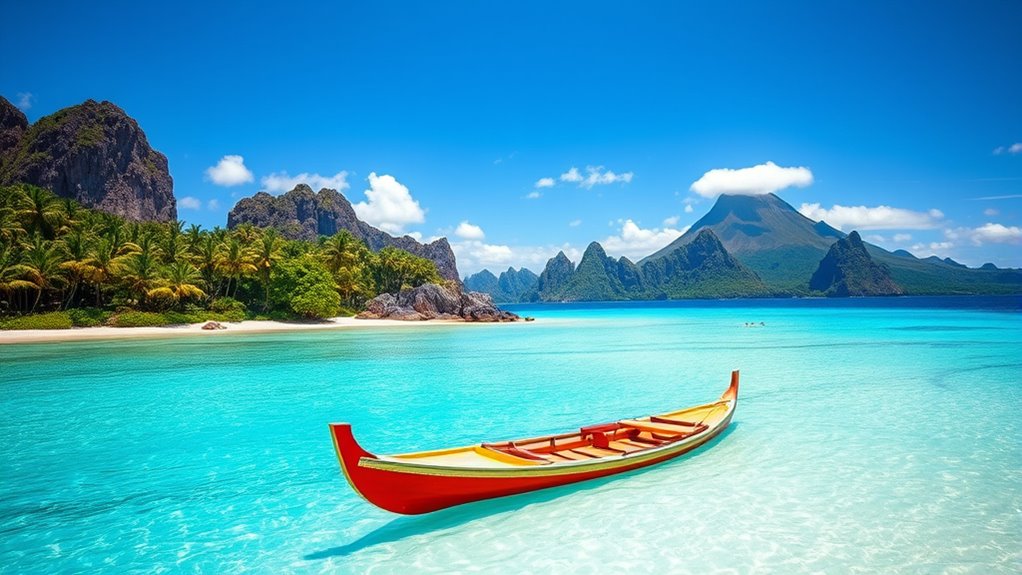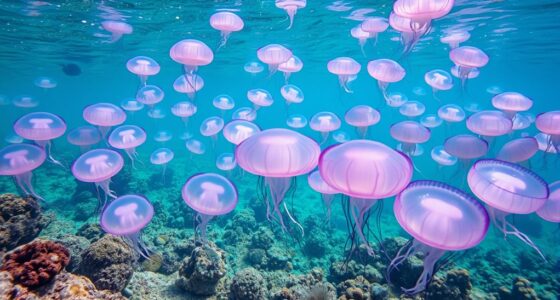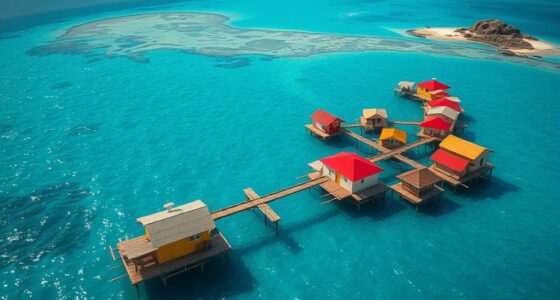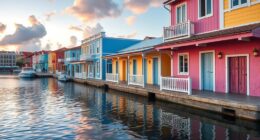In Micronesia, you can explore ancient sites like Nan Madol’s stone city and Lelu Ruins, and walk through lush forests to viewpoints like Sokehs Ridge. Plunge into crystal-clear waters to see vibrant reefs, turtles, and manta rays, or visit Kosrae’s giant clam farm and waterfalls. WWII relics and cultural sites tell fascinating stories of the region’s past. Keep exploring to uncover even more of this incredible island paradise.
Key Takeaways
- Nan Madol in Pohnpei, an ancient basalt stone city and archaeological marvel.
- Lelu Ruins in Kosrae, featuring 13th-century walls and tombs of early local royalty.
- WWII relic sites on Pohnpei and Kosrae, including artillery, tanks, and wrecks suitable for exploration.
- Vibrant coral reefs and marine ecosystems around Micronesia, offering excellent snorkeling and diving experiences.
- Natural attractions like Kosrae’s waterfalls, Sokehs Ridge on Pohnpei, and lush tropical forests across the islands.
Discover Micronesia’s Historic and Natural Wonders
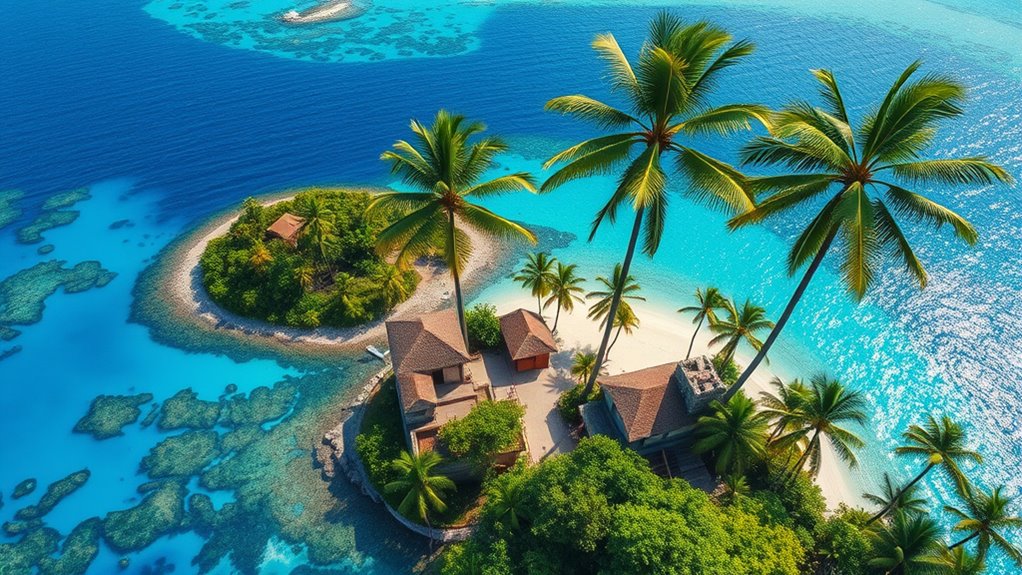
Micronesia offers a wealth of attractions that appeal to history enthusiasts, nature lovers, and adventure seekers alike. As you explore, you’ll find ancient ruins and archaeological sites that reveal the region’s rich past. In Kosrae, the Lelu Ruins stand out with their 13th-century basalt walls, tombs, and remnants of an ancient capital, giving you a glimpse into early Micronesian civilization. Nearby, Kosrae also hosts prehistoric burial mounds and dwelling compounds linked to local royalty from the 13th and 14th centuries, offering a fascinating immersion into the island’s regal history. Traveling to Pohnpei, you’ll encounter the legendary Nan Madol, a sprawling stone city dating from the earliest centuries, with extensive basalt structures built without mortar. Its mysterious origins and impressive architecture captivate visitors and make for an unforgettable adventure. Throughout Pohnpei and Kosrae, scattered World War II relics—artillery, tanks, and gun batteries—remain largely forgotten but accessible, inviting you to explore these historic remnants of the Pacific conflict. For marine history buffs, the wrecks of 19th-century whaling ships near Kosrae serve as popular diving sites, where you can witness the submerged echoes of a bygone era.
Nature lovers will find Micronesia equally enchanting. Kosrae’s Giant Clam Farm offers a unique opportunity to observe and learn about native giant clams, while the island’s lush tropical forests and scenic waterfalls like Supyen and Saolong provide spectacular natural escapes. Pohnpei’s mangrove forests, accessible by kayak, create serene environments perfect for birdwatching and peaceful exploration. At the Eel Pools, large, tame eels welcome visitors, offering an unusual and engaging wildlife encounter. The waters surrounding Micronesia teem with vibrant marine life, including turtles, dolphins, manta rays, and coconut crabs—though the latter are protected, highlighting the region’s commitment to conservation. Kosrae’s pristine reefs, visible even from the shore, offer excellent snorkeling with visibility over 200 feet, revealing an underwater world filled with colorful coral and fish. Additionally, the region’s vetted wet cat foods demonstrate the importance of preserving marine ecosystems, as healthy reefs support diverse aquatic life.
For those seeking outdoor adventure, Sokehs Rock on Pohnpei presents a massive monolithic cliff shrouded in myth, while the Sokehs Ridge hike offers panoramic views of WWII relics, mangroves, and island peaks on a challenging 3-mile trail. Kosrae’s Mt. Finkol, the island’s highest peak, rises over 2,000 feet and rewards hikers with sweeping rainforest vistas. Scenic pathways wind through lush forests and volcanic crash sites, especially on Yap Island, where tropical gardens and geologic formations create dramatic landscapes. Whether you’re exploring archaeological marvels, exploring vibrant reefs, or trekking through tropical forests, Micronesia’s diverse attractions promise an enriching adventure filled with history, natural beauty, and cultural discovery.
Frequently Asked Questions
What Is the Best Time of Year to Visit Micronesia?
The best time to visit Micronesia is during the dry season, from December to April. During this period, you’ll enjoy sunny skies, pleasant temperatures, and calmer seas, perfect for exploring and water activities. Avoid the rainy season from May to November, when storms and high humidity can interfere with your plans. Planning your trip around these months guarantees you get the best weather and experience all the island’s beauty.
Are There Any Cultural Festivals Visitors Should Experience?
Imagine stepping into a living tapestry—there, you’ll find vibrant cultural festivals that you shouldn’t miss. You can experience the Chuuk Lagoon Festival, where traditional dance, music, and boat races paint a picture of Micronesia’s rich heritage. Visiting during these lively celebrations lets you connect deeply with local customs and stories, making your trip truly memorable. Be sure to check local schedules for dates and festivities!
How Safe Is Travel Within Micronesia for Tourists?
Travel within Micronesia is generally safe for tourists, but you should stay cautious and aware of your surroundings. Follow local advice, avoid risky areas, and keep your belongings secure. Use reliable transportation options and stay updated on weather conditions, especially during typhoon season. By taking these precautions, you can enjoy your trip confidently, knowing you’re doing your part to stay safe while exploring this beautiful region.
What Are the Local Customs and Etiquette to Observe?
You should respect local customs and etiquette, as Micronesian communities value politeness and hospitality. Approximately 90% of residents speak traditional languages, so learning a few basic phrases like “hello” and “thank you” shows respect. When visiting villages, always ask permission before taking photos and dress modestly, especially in sacred sites. Showing genuine interest in their culture fosters positive interactions and enriches your travel experience.
Can I Participate in Traditional Micronesian Activities or Crafts?
Absolutely, you can participate in traditional Micronesian activities and crafts. Locals are friendly and often welcome visitors to join in activities like weaving, carving, or traditional dance. Just show respect and enthusiasm, listen carefully to instructions, and ask permission first. Participating gives you a deeper understanding of their culture and creates meaningful connections. Embrace the experience, and you’ll leave with unforgettable memories and new skills.
Conclusion
As you explore Micronesia’s stunning sights, it’s almost like the islands themselves whisper secrets of history and nature. You might find yourself wandering from ancient ruins to pristine beaches, feeling unexpectedly drawn in by the islands’ charm. It’s no coincidence that so many travelers return, captivated by this hidden paradise. Micronesia’s wonders leave a lasting impression, reminding you that sometimes, the most unforgettable experiences happen when you least expect them.

